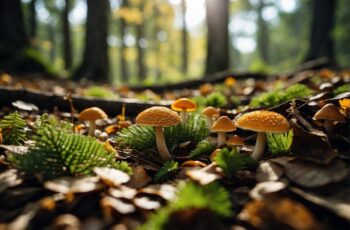Mushroom hunting is an engaging activity that combines the thrill of the hunt with the reward of finding delicious and sometimes rare fungi. As a pastime practiced around the world, it offers a unique opportunity to explore the outdoors and connect with nature. Whether you’re a seasoned forager or a curious beginner, understanding the basics of mushroom hunting is essential for a safe and successful outing. Knowing where to look for mushrooms, including the types of trees and habitats they associate with, is just the beginning of this fascinating hobby.
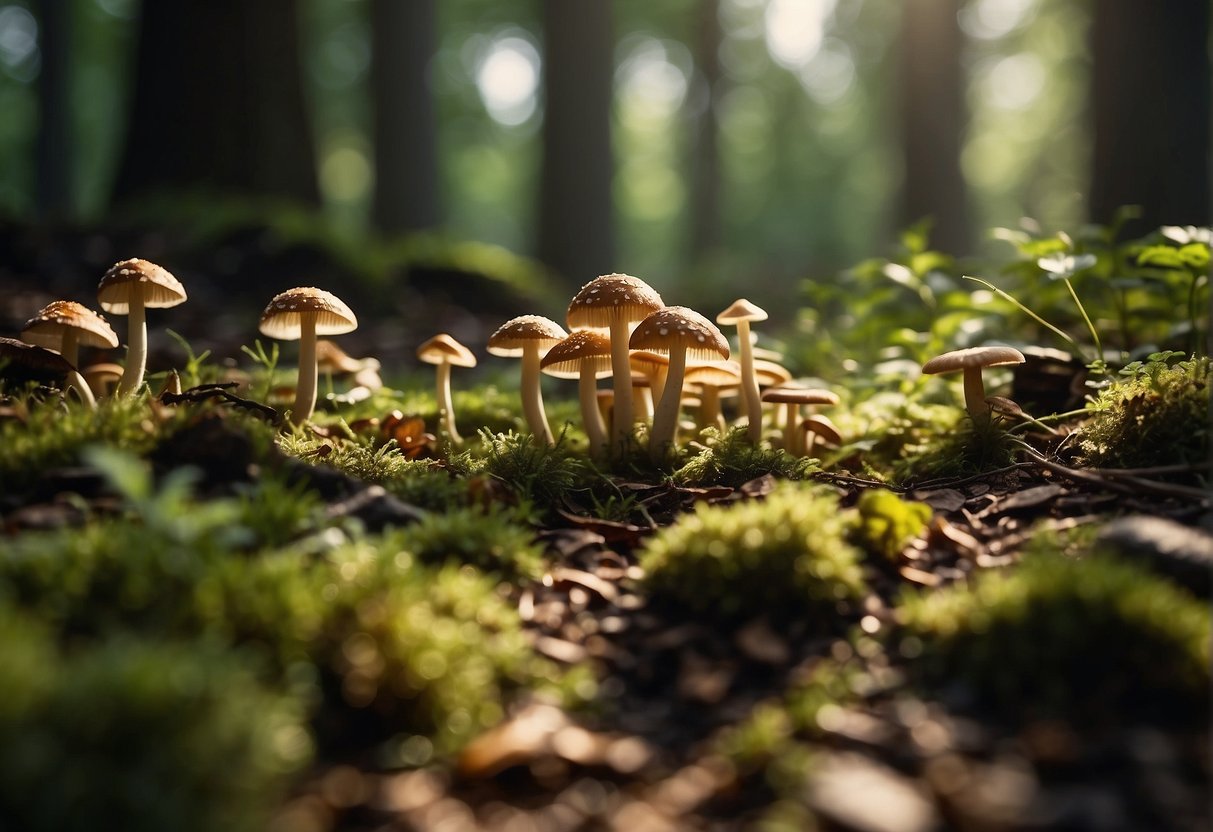
Equipped with a basket, a small knife, and a mushroom identification guide, you can embark on an adventure that not only brings you closer to the earth but also can culminate in a delightful culinary experience. It’s important to remember that some mushrooms can be toxic, so proper identification is crucial before consumption. Resources like field guides or workshops with experienced foragers can be invaluable for learning which mushrooms are safe to harvest. As you gain experience, you’ll start to recognize various mushroom varieties and learn the best practices for sustainable harvesting, ensuring the continued growth of these natural treasures.
Key Takeaways
- Mushroom hunting merges outdoor exploration with the joy of finding edible fungi.
- Accurate identification and familiarity with mushroom environments are critical.
- Sustainable harvesting practices help preserve mushroom populations for the future.
The Basics of Mushroom Hunting
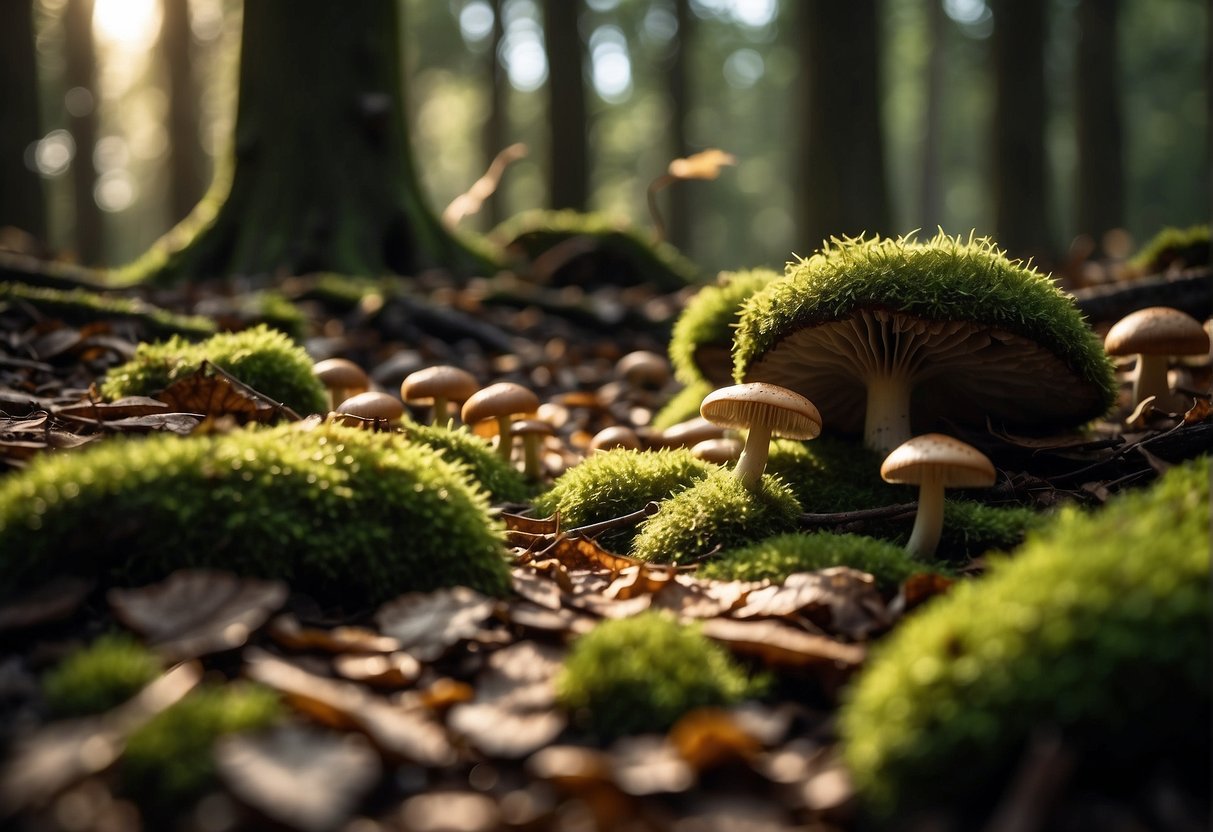
Mushroom hunting is a rewarding outdoor activity that combines the thrill of the hunt with the pleasure of being in nature. You’ll need to be well-equipped, know what you’re looking for, ensure your safety, and understand when and where to search for these elusive fungi.
Understanding Morel Mushrooms
Morel mushrooms are a prize find for foragers due to their distinctive honeycomb appearance and delicious taste. They typically emerge in North America during spring, when soil temperatures reach around 45 to 50 degrees Fahrenheit. The season can vary but often peaks in April and May.
Essential Gear for Foragers
To set out on a mushroom foraging adventure, you’ll need some basic gear:
- A basket to allow spores to disperse as you carry your finds.
- A knife for cleanly cutting the mushroom stem.
- Comfortable and durable clothing, including long pants and sturdy boots.
- A guiding book or app for mushroom identification recommended by the North American Mycological Association.
Mushroom Foraging Safety
Safety is paramount in mushroom hunting. Always assume a mushroom is poisonous unless you are 100% certain of its identity. Never consume a mushroom based on guesswork. It’s wise for beginners to participate in an educational foray with experienced foragers.
Best Times and Places for Mushroom Hunting
The best time for mushroom hunting is a few days after rain during the mushroom season, with early mornings being ideal. Look for morels in areas with moist soil, such as riverbanks or forests with elm, ash, or apple trees. Always ensure you’re not on private land without permission, and check state regulations if you’re picking mushrooms in public areas.
Identifying Trees and Habitats
When setting out on a morel mushroom hunt, your success hinges on recognizing the right trees and understanding the habitat preferences of these elusive fungi.
Tree Identification for Morel Hunting
Elm Trees: Spotting the right trees is crucial for finding morels. Elm trees, often dying or dead, with their gray, vertically fissured bark resembling braided patterns, are classic indicators. Their leaves are oval with a pointed tip and jagged edges.
Ash Trees: Ash trees also signal good morel habitats. Their leaves are compound with 5 to 11 leaflets and their bark has a unique diamond pattern.
To assist you on your hunt:
- Seek out hardwood forests as these are hotspots for morel activity.
- Keep your eyes peeled for the characteristic bark and leaf patterns of elm and ash trees.
Foraging in Various Soil Types
Sandy Soil: Sandy areas, especially near water sources, are often fruitful for morel foraging. However, make sure the soil is not too dry, as morels thrive in moist soil.
Moist Soil: Look for areas that have well-draining yet moist soil. The ideal conditions are usually found in forests with a mix of shade and sunlight, allowing the soil to stay damp without being waterlogged.
Remember:
- Feel the soil; it should be moist but not saturated.
- Areas with a mixture of shade and sunlight are promising spots.
By paying close attention to these details, you’ll increase your chances of a successful morel mushroom hunt.
Mushroom Varieties and Their Environments
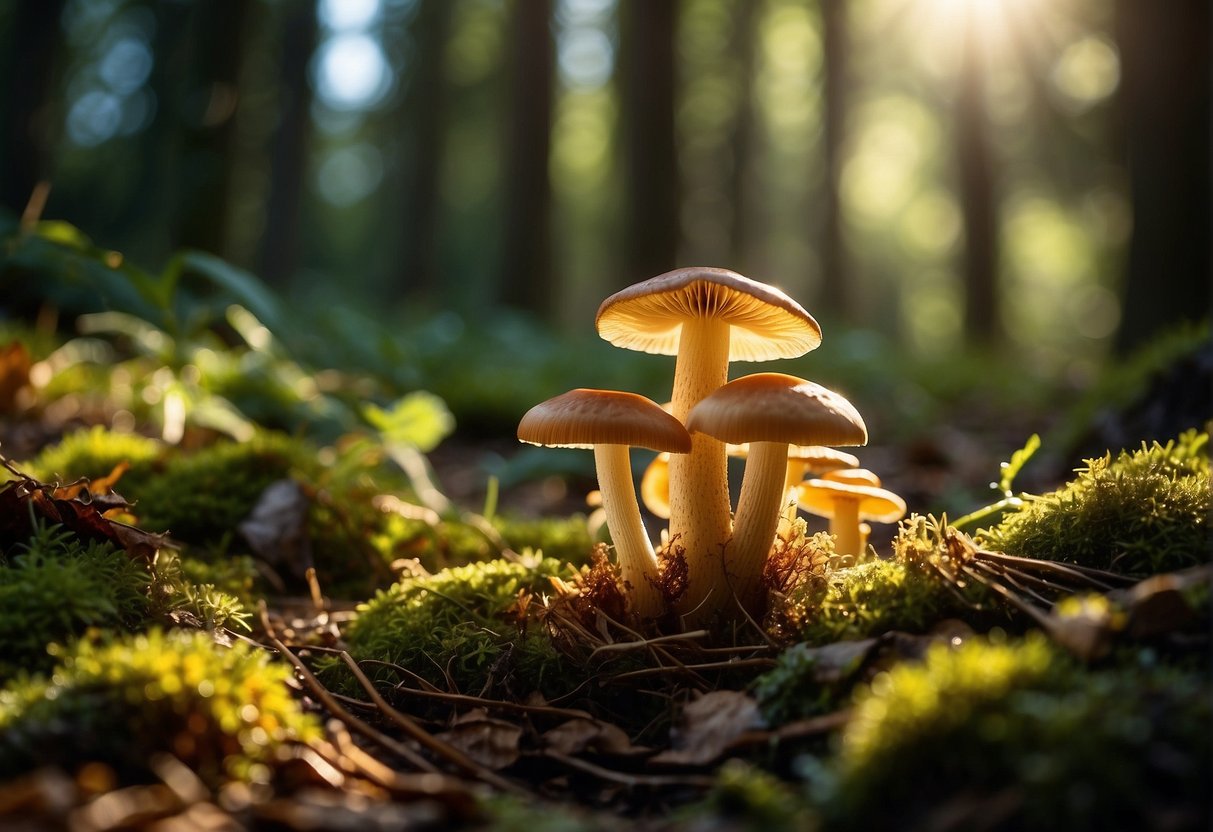
Exploring the diverse world of wild mushrooms can be a rewarding experience, especially when you recognize the regional varieties and learn to distinguish edible species from poisonous ones. Understanding the environments where different mushrooms thrive is key to a successful forage.
Regional Mushroom Varieties
In North America, mushroom varieties are as varied as the regions in which they grow. The Pacific Northwest is famous for its moist climate, ideal for the coveted morel growth. You’ll often find these prized fungi in recently burned areas or coniferous forests. The Northeast is home to the sought-after chanterelles, which prefer hardwood forests, especially around oak and beech trees.
Moving to the Midwest, expect to discover an abundance not only of morels but also of oyster mushrooms, particularly on dead or dying hardwood trees. If you’re in the South, humidity plays to your favor, coaxing out a variety of wild mushrooms, including inky caps and shaggy manes, which often pop up in grassy areas after rain.
Recognizing Edible and Poisonous Species
Foraging for edible mushrooms carries the thrill of the hunt alongside the need for caution. Oyster mushrooms are relatively easy to identify with their oyster-shaped caps and grow in clusters on wood. They are a safe and delicious find. On the other hand, poisonous mushrooms, like some inky caps, can look innocent but pose serious risks.
It’s imperative to differentiate between edible varieties and those that are not. Chanterelles are a delicious find, identifiable by their yellow to orange color and funnel-shaped caps. However, they have a dangerous look-alike known as the false chanterelle. Remember, when in doubt, it’s crucial to err on the side of caution; never consume a mushroom unless you are absolutely certain of its identity.
Practical Approaches and Resources
Embarking on a mushroom hunting adventure requires a blend of traditional methods and modern tools. Make the most of cutting-edge technology to navigate the terrain and lean on the wisdom of mycological literature for successful foraging.
Utilizing Technology and Maps
Technology: Harness the power of GPS to pinpoint potential hotspots for popular mushrooms like the elusive morel. Apps like onX Hunt provide detailed topographical maps and the ability to mark waypoints for your favorite foraging spots, making it easy for you to return to fruitful locations.
Interactive Maps: Combining satellite imagery from Google Maps with your GPS data can lead you to promising mushrooming territories. Look for areas with the right conditions—be it dense forests or moist areas—where mushrooms are more likely to thrive.
Learning from Books and Mycology Experts
Books: Acquire a reliable mushroom field guide that suits your region. Books such as “The Complete Mushroom Hunter” not only guide you through mushroom identification but also share insights into the lifecycle of fungi, enhancing your understanding of when and where to search.
Mycologists: Attending workshops or talks by mycology experts can be incredibly enlightening. These specialists share firsthand experiences and up-to-date articles that can expand your knowledge and improve your identification skills, reducing the risk of dangerous misidentification.
Harvesting and Aftercare
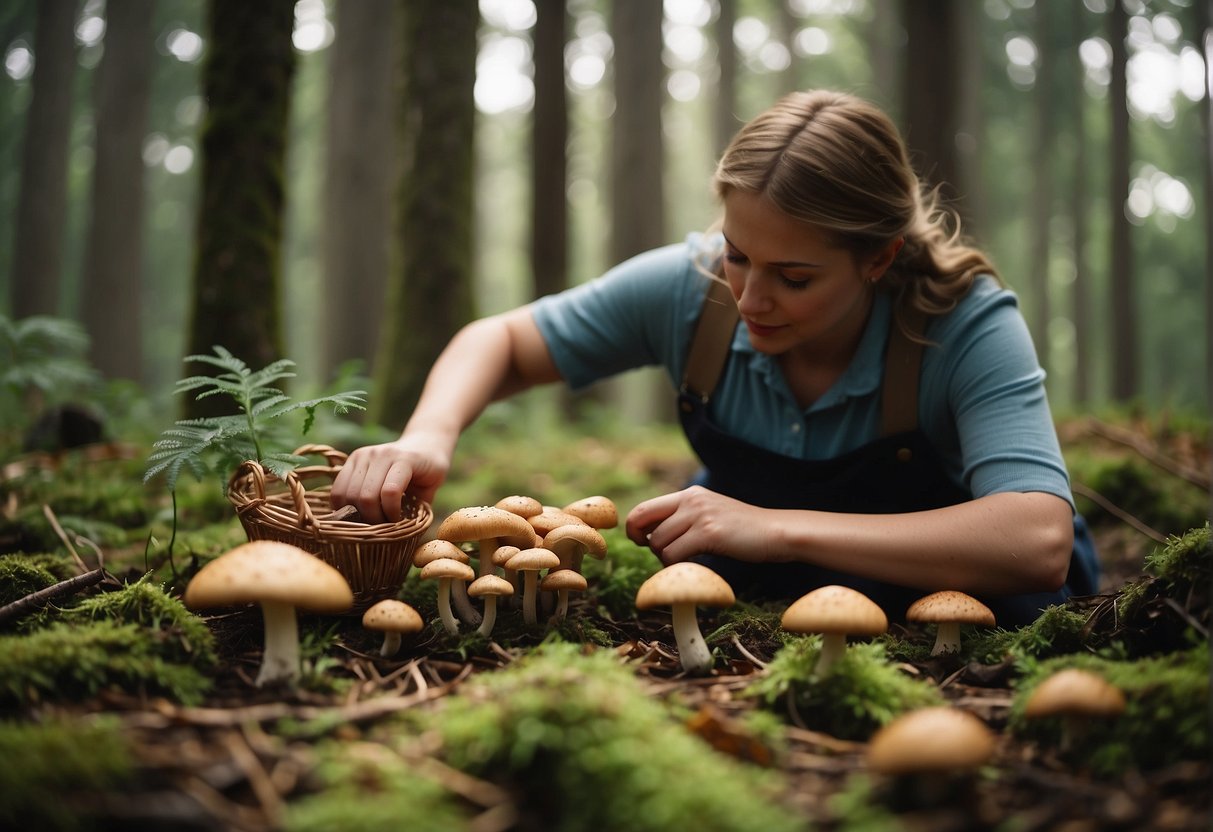
When you return from your foraging adventure, the success of your harvest hinges on the care and attention you subsequently give to your finds. Proper aftercare ensures the value of your mushrooms, whether for personal consumption or potential buyers.
Sustainable Foraging Practices
When harvesting mushrooms, always consider the environment to keep the ecosystem thriving for future foragers.
- Use Mesh Bags: Carrying your mushrooms in a mesh bag allows spores to disperse as you walk, promoting regrowth.
- Be Selective: Harvest only mushrooms in abundance; avoid over-picking a single type, especially if it’s rare like chanterelles.
- Cut Carefully: Use a knife to cut the stem rather than pulling out the mushroom, to preserve the mycelium below ground.
By adhering to these practices, you ensure that mushroom populations replenish, maintaining a sustainable hobby or livelihood.
Cleaning, Storing, and Cooking Your Finds
After foraging, cleaning your mushrooms correctly is crucial to maintain their quality.
- Cleaning: Gently brush off dirt with a soft brush before storing.
- Storing: Keep them in a paper bag in the fridge to prolong freshness for a few days.
When it’s time to enjoy your bounty, mushroom recipes are plentiful and varied. Treat your mushrooms as you would any ingredient from a fine food market, cooking them in a way that highlights their unique flavors. Restaurants and gourmet cooks favor certain wild mushrooms like chanterelles for their distinctive taste, so consider trying recipes that let these kinds of mushrooms shine.
Remember, the prices you might fetch from buyers or the quality on your dinner table directly relate to the care you put into harvesting and aftercare practices. Keep it sustainable, keep it fresh, and keep exploring the rich world of mushrooms demystified through your culinary endeavors.


